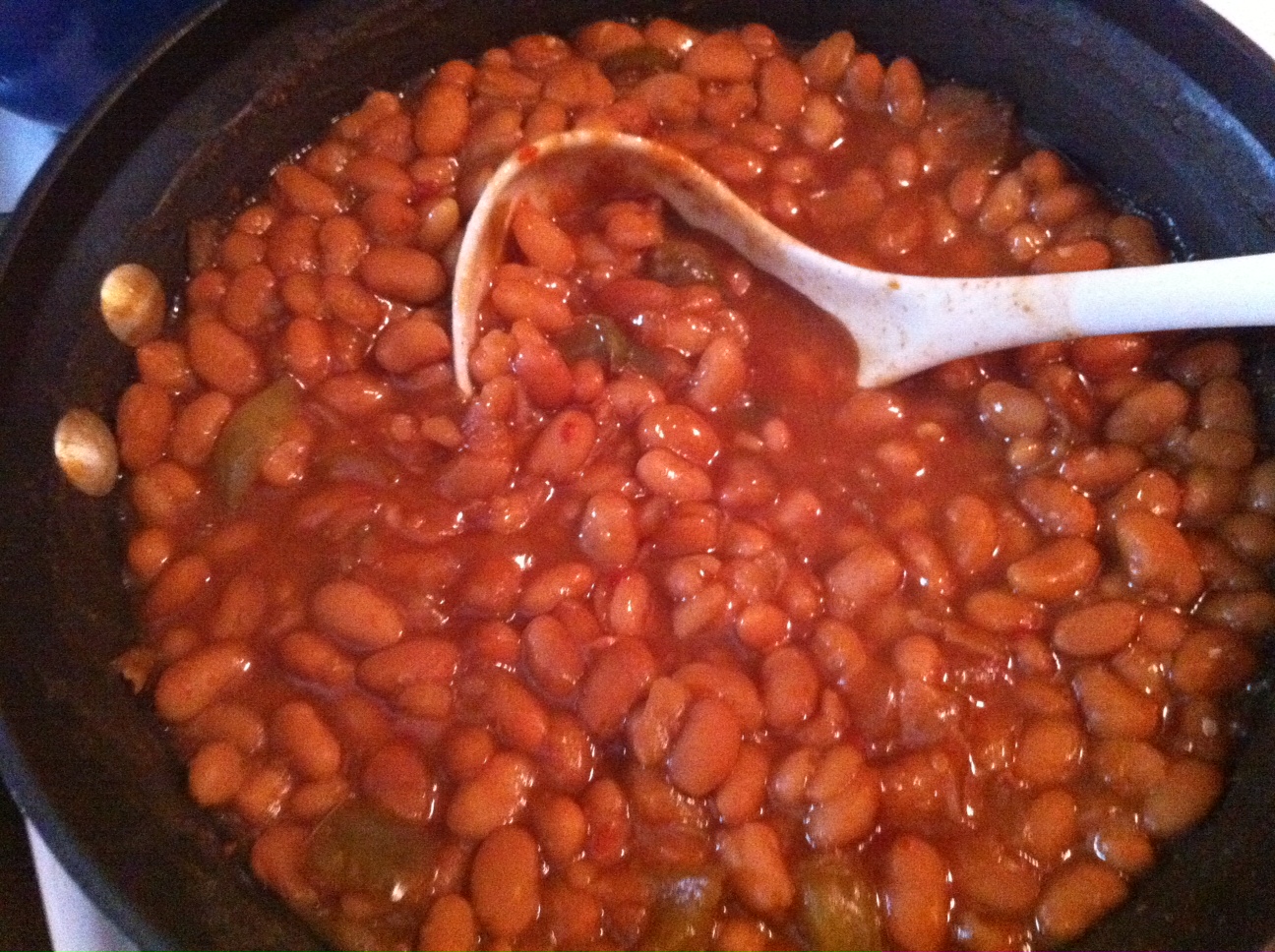24 Sep
Phyllis’ Old-Fashioned Baked Beans (Vegan or Vegetarian)
 “If there’s a secret to any of the few dishes I can create, it’s simplicity. And sugar, you can never go wrong with sugar.” – Phyllis (my mother)
“If there’s a secret to any of the few dishes I can create, it’s simplicity. And sugar, you can never go wrong with sugar.” – Phyllis (my mother)
Sage words, indeed. Phyllis said this in response to my fanatical raving about how awesome my baked beans turned out after I used her recipe for a 4th of July party and asked her where the heck she got it from. It is a dish that she has distilled to perfection over several decades of experimentation, based on a – yes, seriously – Betty Crocker original from a cookbook that she was given as a wedding gift in the 60s. Anyway, don’t let its humble origin fool you. These beans are fantastic and if you serve them at a party, they will disappear in short order.
A word about baked beans in general. They are a Midwestern potluck and bbq staple, and as such, we must make certain allowances for their unique strategy for tastiness. I am often a little hesitant and bashful to share the ingredients of some Sweet Home recipes of mine, because people are sometimes shocked at their … pragmatism, to put it delicately. In more candid terms, what I mean is that on the West coast I think people usually assume anything delicious comes from fresh, organic, farm-raised, sustainably produced, obscure and esoteric ingredients. Not always so back at Sweet Home. See, there’s this magic, versatile substance that is a mainstay of countless classics, which can be substituted for any number of more expensive, time-consuming and unpredictable ingredients … trust me, you’d be amazed. The mystery food in question. Is.
Catsup. There, I said it.
Now, before you judge me for using catsup instead of something more bohemian (not that you would, I’m just projecting), please consider for a moment the controversial cultural origin of America’s favorite condiment. For instance, it’s been theorized that modern catsup has origins as distant and arcane as 16th century Chinese tomato and fish sauces, or possibly similar time period Indonesian, Thai or Phillipino concoctions, or even possibly 17th century European adaptations of an Arabian pickling sauce, which evolved from the Arabic term “kabeees,” anglicized to “caveach,” the term for something you might know as “escabeche.” The thing is, food and language historians can’t agree. So instead of thinking of catsup as something commonplace and American, let’s appreciate it’s exotic and mysterious properties. And further, with these potential Asian/Indo/Euro origins in mind, I’d like to postulate a theory about the genealogy of old-fashioned “American” baked beans as we now know them, and suggest that perhaps they’re not too distantly related to the beloved Indian dish known as chana masala? Think about it – the white beans, the sweet and sour sauce, the hint of spiciness? Anyway, this is how I like to think about them. Don’t talk to me about English breakfasts or Boston beans. Chana masala is my story and I’m sticking to it. The end.
So without any further ado …
Phyllis’ Old-Fashioned Baked Beans
- 1 large green bell pepper, diced
- 1 large white onion, diced
- 1 – 2 jalapeños, minced
- 2 – 3 cloves garlic, minced
- Dash of cayenne
- 6 cans navy beans (cannelinis could work too)
- Ketchup to taste (~2 tbsp
- Brown sugar to taste (~1 cup)
- Salt to taste
- 5 tbsp olive oil or butter to be used in phases (if you choose butter that renders it unvegan, obvi)
Preheat oven to 300.
Heat a large skillet on medium. When the skillet is hot, add 2 tbsp olive oil or butter. When the oil or butter is hot, add the onions, pepper and garlic, and saute until softened. Salt to taste and stir in a dash of cayenne, to taste. Set aside to combine with the beans later.
To prepare the beans for baking, in the words of Phyllis:
“I use a rectangular cake pan but it doesn’t matter. Layer 1 to 2 inches of beans, sprinkle brown sugar generously over beans.* Continue layering until you reach the amount you want. At the top, instead of brown sugar, layer catsup . Doesn’t matter how much. I’m not crazy about catsup so I don’t use lot. Bake around 300 for about 45 min or until the catsup on top is thickened and beans are hot. Salt if preferred.”
*At this juncture I should point out a couple of departures I made from Phyllis’ method. For one, when I was layering the beans and brown sugar, I also dropped in small pats of butter for each layer. When I talked to her live she told me that sometimes she does it. You could also drizzle a tiny amount of oil or vegan butter instead. This is not mandatory but does add a creamy, rich flavor.
Also, the vegetables are my own embellishment. They are not standard but intended to make up for the fact that she usually makes them with ham or bacon or both, so I wanted to add flavor to compensate for the absence of pork.
Anyhoo, after you follow Phyllis’ method of preparing the beans, when they are five minutes from fully baked, pull them out of the oven and stir in the sauteed vegetable mixture. If you like, drizzle a bit more catsup on top and then bake for another 5 minutes or so. Serve hot.

Recent Comments